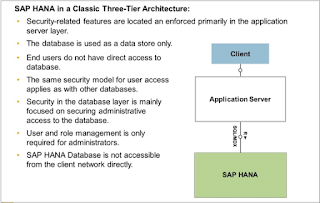Main
storage and delta storage.
As only
data in memory is relevant, the load status of tables is significant. A table
can have one of the following load statuses:
●
Unloaded, that is, none of the data in the table is loaded to main memory
● Partly
loaded, that is, some of the data in the table is loaded to main memory, for
example, a few columns recently used in a query
● Fully
loaded, that is, all the data in the table is loaded into main memory
Loading
and Unloading of Data in the Column Store
The SAP
HANA database aims to keep all relevant data in memory.
Standard
row tables are loaded into memory when the database is started and remain there
as long as it is running. They are not unloaded.
Column
tables, on the other hand, are loaded on demand, column by column when they are
first accessed.
This is
sometimes called lazy loading. This means that columns that are never used are
not loaded and memory waste is avoided.
Note This
is the default behavior of column tables.
In the
metadata of the table, it is possible to specify that individual columns or the
entire table are loaded into memory when the database is started
Load/Unload
a Column Table into/from Memory
Under
normal circumstances, the SAP HANA database manages the loading and unloading
of tables into and from memory independently,
the aim
being to keep all relevant data in memory. However, you can manually load and
unload individual tables, as well as load table columns if necessary.
Privilege
● System
privilege TABLE ADMIN
● SQL
object privilege UPDATE for the table or the schema in which the table is
located
Load and
Unload a Table Using SQL
Open the
SQL console and execute the required statement:
LOAD <table_name>
UNLOAD <table_nam
LOAD <table_name> (<column_name>, ...)
Results
The
entire column is loaded into main memory. Its load status is TRUE. The table's
load status is PARTIALLY.
Managing
Memory by Object Usage
The
time-based parameter
unused_retention_period. is available for this in the global.ini file.
To use
this feature change the default value (initially set to 0) to a number of
seconds, for example 7200 (2 hours). Objects which are not used within this
time period are flagged as being eligible to unload.
Objects
which have exceeded the retention period are not immediately unloaded from
memory, an additional checking process which runs at a pre-defined interval
initiates the unload. The frequency of the check is controlled by the unused_retention_period_check_interval
configuration parameter. This is set by default to 7200 seconds (2 hours).
Retention
Times and Priorities for Objects
In
addition to the general configuration parameter you can apply a retention
period and an unload priority value to the table or partition definition itself
(see the SAP HANA SQL and System Views Reference for details). The following
example applies an unload retention period of 60 seconds to table myTable.
ALTER TABLE "myTable" WITH
PARAMETERS('UNUSED_RETENTION_PERIOD'='60')
The unload priority value is a number from 0
to 9 where 0 means the object can never be automatically unloaded and 9 means
the earliest unload. Note that retention period values can only be applied to
tables if a configuration value has been set for unused_retention_period in the
global.ini file











